
views
Creating a Physical Barrier

Create an obstacle course out of plastic forks or wooden chopsticks. If cats do not have enough room to move around, scratch, and dig, they will seek another area for a litter box. Insert plant spikes, forks, chopsticks, or similar materials (approximately 10 inches (25 cm) in length) every 8 inches (20 cm) in the soil to thwart cats. Make sure that the sticks or equivalent materials are inserted to a depth of a few inches into the soil so that they will stay upright. The points on these utensils are not sharp enough to cause any real damage, but they can be enough of a deterrent to discourage your feline friends from lounging about.

Embed chicken wire in the soil. Lay standard chicken wire (available from hardware stores) down before your plants poke through the soil. Plants can usually grow in between the gaps, but cats will find the texture of the wiring unpleasant to walk on. The chicken wire will be soft enough not to hurt the cats, but strong enough to discourage them from digging in your garden. If the plants need additional room to grow, you can use wire cutters to cut larger holes directly above the plants needing more room. As an alternative to chicken wire, you can lay plastic sheeting designed for use in gardens.
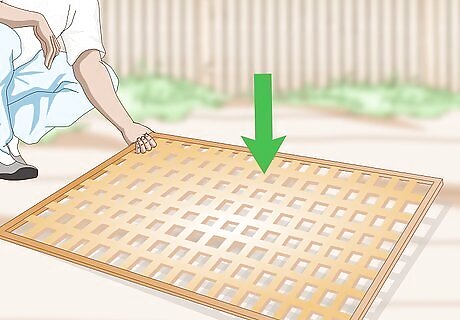
Lay lattice fencing over the ground. Lay the lattice fencing over your soil before you even plant your seeds. The gaps in the fencing will make the area unappealing to wandering cats. Press the lattice fencing into the ground gently so that it is partially covered by the soil. Transplant seedlings and plant seeds into the soil exposed by the gaps of the fencing. Over time, many common garden plants should grow around the fencing without much difficulty.
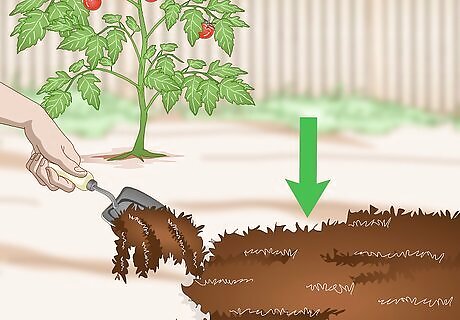
Cover the soil with uncomfortable material. Cats will not like to dig in or play on rough surfaces. You can cover areas of your yard with a thin layer of safe materials like: Rough-textured mulch Prickly pinecones Pebbles and stones
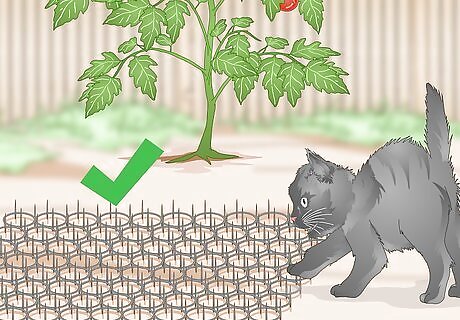
Cover exposed ground with "scat mats." Scat mats (available at garden supply stores) are plastic mats covered in flexible plastic spikes. The spikes are soft enough not to hurt cats, but they will not like the texture and will keep away. Depending on the brand, you will usually find the mats in packages of 2 to 5 mats. Generally, these mats are cut into four pieces, making it easy to fit the mat to size according to the size and needs of your garden. Do not merely lay the mats on the surface of the soil. You need to press the mats into the soil so that the mat itself is covered, leaving only the spikes exposed. Otherwise, a clever cat can paw the mat up.
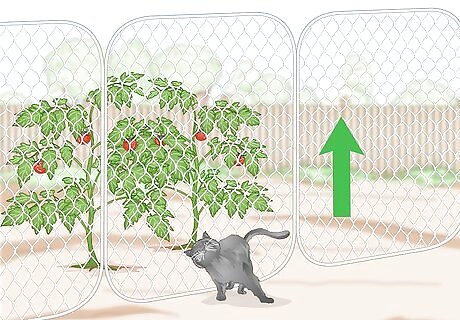
Create a barrier fence. Cats are persistent, and able to squeeze into many places. However, a 6 feet (1.8 m) high chain-link fence, with 2 by 2 inches (5.1 by 5.1 cm) mesh can be effective at keeping cats out of your garden. A 2 ft (0.61 m) overhang can provide additional protection.
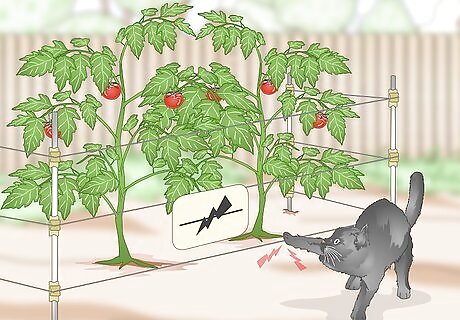
Use a low-voltage wire. An electric fence surrounding your garden can effectively keep cats out of it. As long as it is low-voltage, it will not harm the cats, only drive them away. The fence can be raised about 4 inches (10 cm) from the ground and still discourage them from entering your garden. Look for electric fencing at hardware or home supply stores. Carefully follow all installation and safety instructions. Keep children away from electric fencing.
Detering Cats with the Power of Scent

Plant potent-smelling plants. Cats do not like certain plants, and will stay away from them. Planting them will make the entire area seem disgusting to the local feline population. Try cultivating one or more of these plants near your garden, interspersed among your garden plants, or in other areas of your yard that you do not want cats to disturb: Lavender Rue Geranium Absinthe Lemon thyme Thorny roses Coleus canina, also known as “Scaredy Cat Plant”
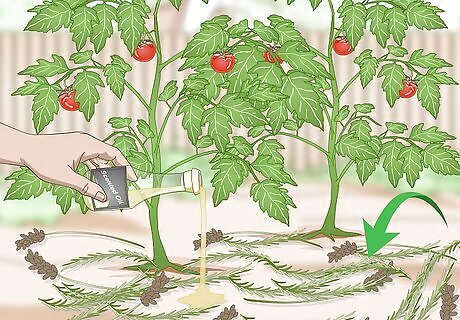
Use dried herbs or scented oils. If you do not want to plant herbs or other plants that cats cannot stand, you could scatter dried versions or sprinkle essential oils derived from these plants around your garden for the same effect. Be sure to check that they are not poisonous to cats or other animals before applying them. Dried rue and lavender are available online or in some garden supply stores. Essential oils of lavender, lemongrass and citronella can be found in some supermarkets or health and beauty stores. You can also try rubbing essential oils on the edges of containers that you have plants in. If you cannot find these herbs or oils, you can achieve a similar effect by sprinkling cayenne pepper in the same way that you would dried herbs.
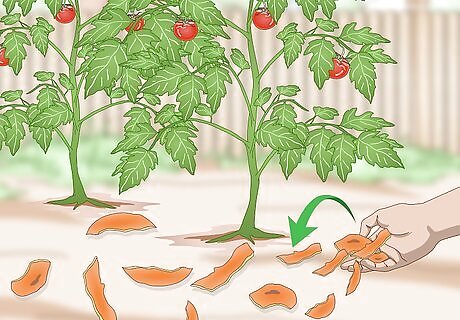
Scatter citrus peels around the garden. Most cats hate the smell of citrus. A quick and easy fix is to scatter fresh or dried peels of lemons, oranges, grapefruits or other citrus fruits over the soil of your garden. The cats will not suffer any harm, but the smell will cause them to seek a more appealing area.

Try coffee grounds or pipe tobacco. Much like citrus, the smells of coffee and tobacco are disgusting to most cats. Simply scatter a thin layer of coffee grounds or tobacco directly onto the soil. However, keep in mind that coffee grounds are toxic to cats and dogs.
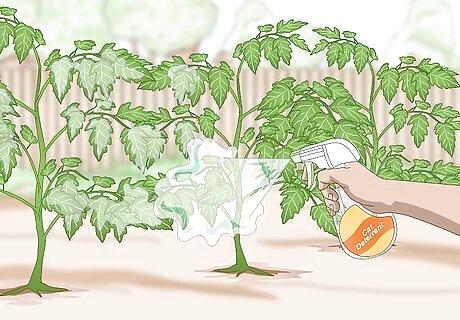
Spray a commercial repellent containing predator urine. Cat deterrent sprays are available at many garden supply stores. Look for a “natural” one that contains an ingredient like the urine of foxes or other predatory animals. These products contain natural ingredients that may deter other animals such as squirrels and rabbits. Always follow the instructions for use very carefully.

Spread batches of your own hair around the garden. In theory, many feral cats do not favor the scent of human hair. As a result, you may be able to keep neighborhood strays away by laying batches of your hair around your garden. Pull the hair from your hairbrushes, and combs, or ask your barber to save hair for you. Lay the strands in bunches around the perimeter of your garden. This method may not deter domesticated cats (including your own) that are used to the scent of human hair.
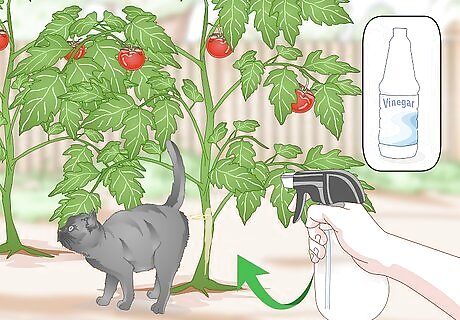
Wash any cat scents away. If a cat has already marked its territory in your garden, you might need to wash its scent away before it will consider going anywhere else. Spraying or pouring ordinary white vinegar around an area that a cat has attempted to “claim” can discourage it from using that spot again.
Scaring Cats Away
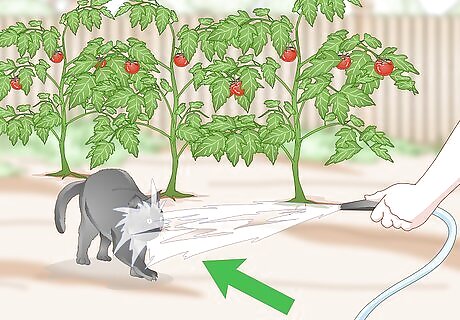
Spray cats with a hose. If you are watchful, you may be able to simply spray cats with a water hose whenever they are trying to use your garden. Cats can be trained, so if you are persistent, this may eventually be enough to permanently drive them away. Be gentle when you are spraying cats with a water hose. Most cats do not like water, so a quick, gentle squirt is usually enough—there is no need for high-powered nozzles, or to thoroughly soak the intruding cats.
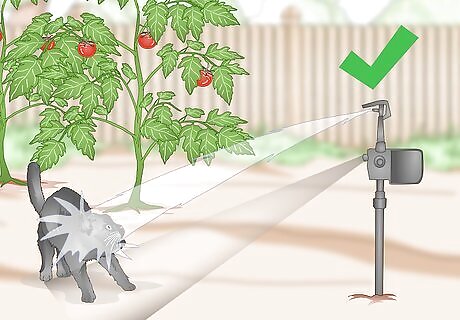
Use a motion-activated sprinkler. Motion-activated sprinklers are available from home supply stores. When a cat walks by, the motion triggers the sprinkler, which sprays a burst of water. Most cats do not like getting wet, so this can often be an effective deterrent. Use motion-activated sprinklers to create a border around your garden. These sprinklers can be installed either permanently or temporarily, depending on your preference and needs.

Use an ultrasonic device to deter cats. These emit a high-frequency sound that cats detest, but which humans cannot hear. These devices are motion-activated, so that when a cat walks by, it is startled by the high-frequency sound and should leave the area. Look for ultrasonic devices at a pet supply store, and use them to create a barrier around your garden.
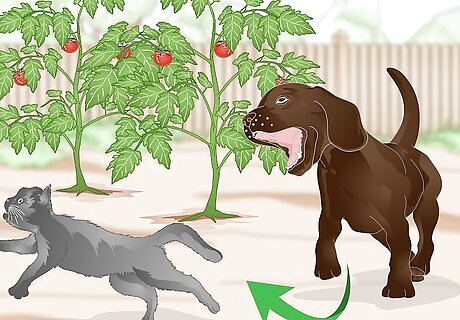
Get a dog. Cats will not linger in areas they do not feel are safe from predators. For this reason, a dog that chases cats can effectively keep them out of your garden.
Making a Peace Offering
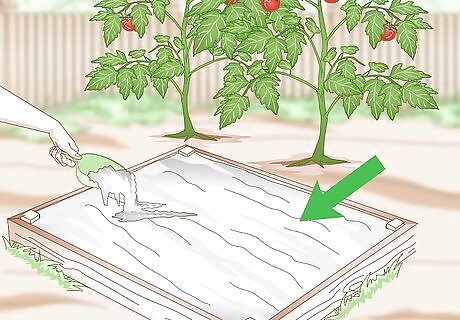
Make a cat sandbox. You can create an alternative outdoor litter box for cats by using a new or old sandbox that is at least as big as a large litter box. Fill it with soft, fine-grained sand (this can be bought by the bag at hardware and home supply stores), which cats find especially attractive. With luck, cats will be drawn to the sandbox instead of your garden and use it much as they would a litterbox. Make sure to scoop the sandbox regularly; if it gets too full, cats may return to using your yard. Keep children away from the cat sandbox, and make sure they understand not to play in it.
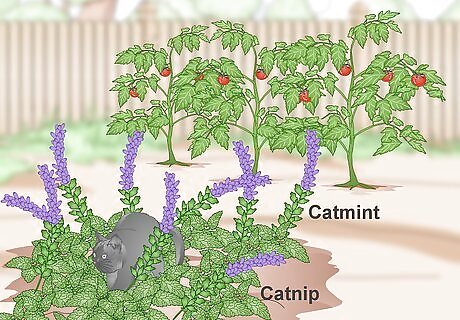
Attract cats to a cat garden. If you want to keep cats out of your garden, but don’t mind them being in other areas of your yard, then try making a cat-friendly area. Cats will be attracted to areas covered by certain plants, and hopefully leave the rest of your yard alone. Create a small plot and grow one or more of the following non-toxic plants in it: Catnip (Nepeta cataria) Catmint (Nepeta mussinii) Cat thyme (Teucrium marum) Valerian (Valeriana officinalis) Spider-plant (Chlorophytum comosum)

Move your bird feeder. If you have a bird feeder near your garden, move it to another area of your yard that is further away. Ideally, you should hang the bird feeder in an area that is too high for a cat to jump to. Otherwise, a bird that visits for a meal might be in more danger than your garden ever was.



















Comments
0 comment